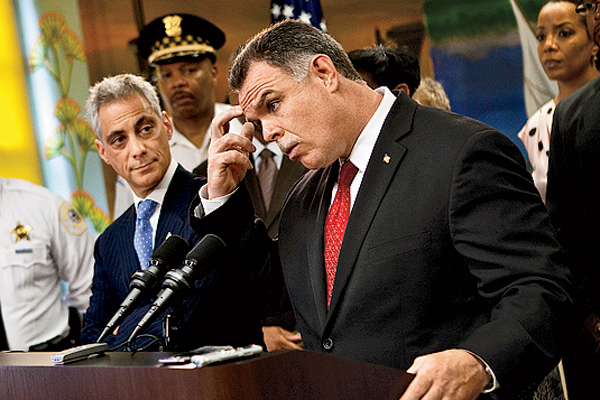We could have told you (and probably did) long ago that Rahm Emanuel would bring more crime to Chicago, if elected Mayor.
We would not have predicted though that murders in Chicagoland are up 38 percent in just one year, thanks to the failed public safety policies of Chicagoland Mayor Rahm Emanuel and Police Superintendent Garry McCarthy.

Corrupt Chicagoland Mayor Rahm Emanuel Under Fire For Policies that Spurred Unbelievably High Murder Rate
As usual, the Democrats in office try and blame the people who held office before them as the reason for the Democrat’s complete and total failures, but brain-dead Emanuel and McCarthy have said that they have no plans to change their badly failed strategy.
Chicago’s mayor and police superintendent publicly defended their new gang-fighting strategy Monday amid growing criticism that the changes are failing and a big reason why the city’s homicide rate has soared this year.
After weeks of media reports about Chicago homicides — which so far are up nearly 38 percent from last year — Mayor Rahm Emanuel and Police Superintendent Garry McCarthy defiantly said during a news conference that the gang strategies in place before McCarthy arrived were the ones that failed, not the new ones.
More beat officers are now on the streets and staying in specific areas, replacing the large, specialized units that would temporarily drop into crime-ridden areas. Emanuel and McCarthy said they have no plans to change that strategy, and the mayor announced Monday that he’s devoting another $4 million to tear down vacant buildings where gang members live and store guns and drugs.
The old tactic of flooding high-crime areas with teams of hundreds of officers for a short period of time, then moving the teams to other areas, was “like putting a band-aid on a gunshot wound,” McCarthy said. “We’re not repairing anything by doing that.”
Emanuel, who has made attacking the city’s street gangs a cornerstone of his administration, was equally dismissive of the effectiveness of those citywide units.
“I don’t think coming in, swatting something down and letting it come back in two weeks is strengthening a community,” he said. “What it does is build up cynicism.”
However, the mayor and police leader rolled out their new anti-gang strategies at a time when the homicide rate was quickly increasing. Among the more recent high-profile deaths was a 7-year-old girl hit by a stray bullet while selling candy outside her home.
And on Monday, the Chicago Tribune ran a front-page story that included blistering criticism from two aldermen whose wards have been the center of much of the gang violence. One alderman said gang members no longer fear that they’ll encounter the so-called strike units, which included dozens or even hundreds of officers who would temporarily saturate violent neighborhoods.
Chicago has averaged about 450 homicides a year since 2005, which is a dramatic drop from the roughly 900 homicides the city was experiencing annually in the early 1990s. Still, McCarthy said the current numbers are unacceptable — and noted that the city recorded about the same number of homicides last year as New York City, which is three times the size of Chicago.
“That’s not success and I’m not willing to take it as success,” said McCarthy, who spent much of his career as a New York City policeman.
He and Emanuel insisted that their crime-fighting strategies are paying off, noting that the city’s overall crime rate has dropped 10 percent compared to the same time last year. McCarthy also said there is evidence that police are on the right track in their fight against street gangs.
“This weekend, there was half the number of shootings, half the number of murders as we had the same time last year,” he said. He also noted that the amount of shootings over the weekend marked the fewest since February.
Quietly, though, some police officers have wondered about the wisdom of disbanding the large specialized units that were deployed by McCarthy’s two immediate predecessors, Jody Weis and Phil Cline.
Weis said Monday that the units, which were sent to locations where a violent incident had occurred or in anticipation of where one might occur, were a big reason why the number of homicides fell when Cline was superintendent and during his last two years on the job.
“No one is proud of that, 450 homicides. But before these units were formed, there were 600,” said Weis, a former FBI agent who was Chicago’s police commissioner from 2008 until early 2011.
McCarthy, who replaced Weis when Emanuel became mayor, said that while Chicago’s police force no longer has those citywide units, it finally has a citywide gang-fighting strategy that it never had before — one that pays special attention to the fact that much of the violence is tied to gangs retaliating against each other.
And Emanuel said there are other components of that citywide strategy, including targeting liquor stores and other businesses that police and community activists have identified as gang hangouts. Several have been closed.
Police also are doing gang audits, so they can identify where specific gangs operate and their members. And the plan the mayor announced Monday calls for the city to spend $4 million to tear down or board up vacant buildings that have been identified as places where gangs live, deal and store drugs, and hide guns.
Gangs, the mayor said, “will not find shelter in the city of Chicago.”
Stand Up To Government Corruption and Hypocrisy – usbacklash.org
